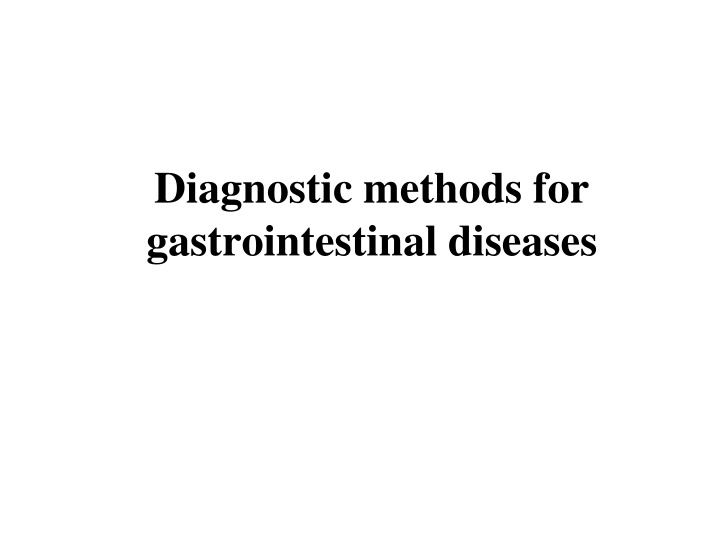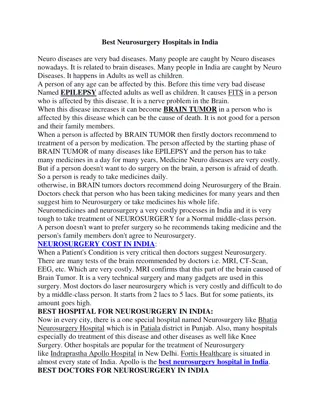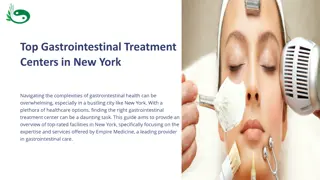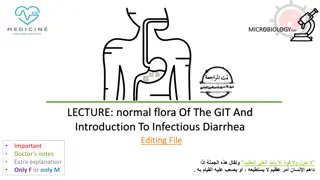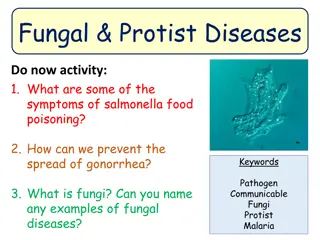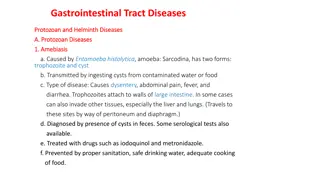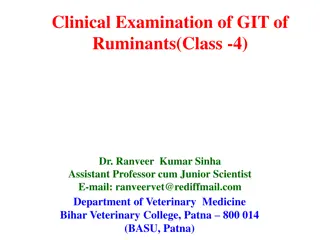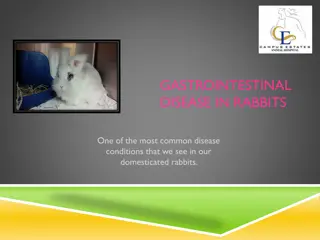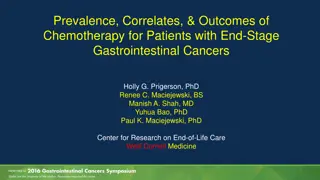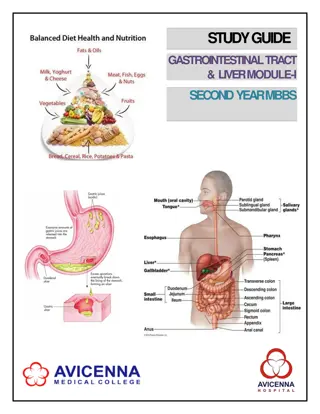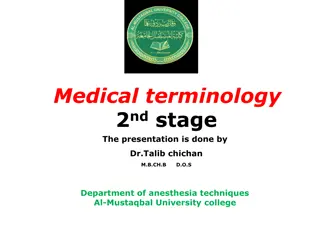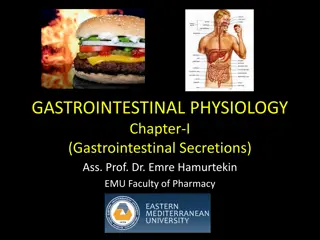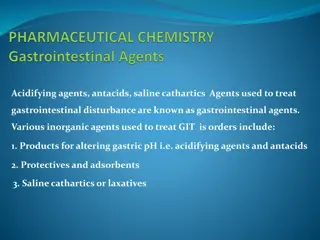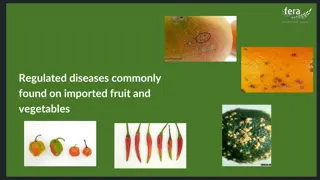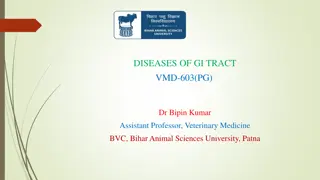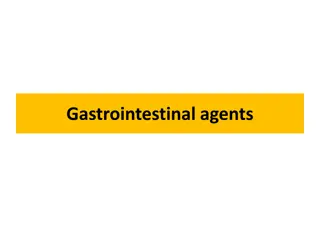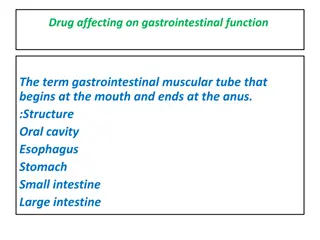Diagnostic Methods for Gastrointestinal Diseases: A Comprehensive Overview
Explore various diagnostic methods for gastrointestinal diseases, including laboratory investigations, abdominal ultrasound features, and radiology techniques. Learn about the significance of different tests such as ESR, blood count, liver tests, and abdominal ultrasound in diagnosing conditions affecting the digestive system. Discover the roles of imaging modalities like Doppler ultrasound, contrast-enhanced ultrasonography, and upper GI barium radiography in evaluating GI disorders. This comprehensive guide provides valuable insights into diagnosing gastrointestinal ailments effectively.
Download Presentation

Please find below an Image/Link to download the presentation.
The content on the website is provided AS IS for your information and personal use only. It may not be sold, licensed, or shared on other websites without obtaining consent from the author.If you encounter any issues during the download, it is possible that the publisher has removed the file from their server.
You are allowed to download the files provided on this website for personal or commercial use, subject to the condition that they are used lawfully. All files are the property of their respective owners.
The content on the website is provided AS IS for your information and personal use only. It may not be sold, licensed, or shared on other websites without obtaining consent from the author.
E N D
Presentation Transcript
Diagnostic methods for gastrointestinal diseases
Laboratory investigations ESR: increased: inflammation, tumors (but can be normal) Blood count leukocytes: : inflammation eosinophilia: helminthiasis, allergy anemia (Hb, HCT): GI bleeding (manifest or occult) Se Iron : bleeding, malabsorption, chr.infection
Laboratory investigations Liver tests: AST(GOT), ALT(GPT): cell damage ALP, GGT, bilirubin: cholestasis prothrombin time , se albumin : liver failure Pancreas: amylase, lipase, functional tests Fecal occult blood test (FOBT) Stool cultures for bacteria and parazites Urine: jaundice, uroinfection, kidney stone
Abdominal ultrasound features specific US methods Doppler-ultrasound - for vascular lesions US-guided biopsy Contrast enhanced ultrasonography EUS- endoscopic ultrasound - endosonography
Abdominal ultrasound Liver echogenity, masses, cysts, bile ducts, veins Biliary tract gallstones (hyperechoic lesion with acoustic shadow), sludge, CBD stones, cholecystitis Pancreas acute pancreatitis, chr.pancreatitis, pseudocysts, tumors Others ascites, organomegalies, lymph nodes, appendicitis, intraabdominal masses (tumor, abscess, cyst, inflammatory mass), kidneys
Radiology Plain abdominal X-ray free air (upright position) gas/fluid levels within dilated loops calcifications Upper GI barium radiography (single or double contrast studies) esophagus (first examination in dysphagia) contour, peristalsis, folds motility disorders, stenoses
Radiology Upper GI barium radiography stomach and duodenum peristalsis, emptying, shape, folds, retrogastric space perforation: with water-soluble contrast agent in case of GI hemorrhage: endoscopy Barium study of the small bowel small bowel follow through study enteroclysis stenoses, polyps, mucosal alterations, ileitis terminalis
Radiology - angiography diagnosis of vascular diseases, obscure GI bleedings therapeutic angiography is evolving (chemoembolisation of tumors, occluding bleeding vessels, dilation of vessels)
Computer tomography features specific CT methods contrast agents (orally administered, iv.) CT-guided biopsy virtual colonoscopy
Computer tomography Liver masses (benign, malignant [primary or metastatic neoplasms], hemangiomas, cysts, abscesses) , cirrhosis, ascites and other signs of portal hypertension, lymph nodes Biliary tract dilated bile ducts, imaging of CBD, distal bile duct stones, CBD neoplasms
Computer tomography Pancreas neoplasms: diagnosis, staging acute pancreatitis: extent of necrosis, peripancreatic fluid collections, guided biopsies chr. pancreatitis: pseudocysts, calcifications Miscellaneous staging of gastrointestinal malignancies, intra-abdominal masses (abscess, inflammatory, tumors), invasion of adjacent structures
Magnetic resonance imaging generally not superior to CT in abdominal diseases sensitive very expensive special methods MR angiography MRCP - magnetic resonance cholangio- pancreatography
Endoscopy features diagnostic endoscopy provides histological sampling (biopsy, brush cytology) therapeutic endoscopy
Upper GI endoscopy Esophagogastroduodenoscopy (EGD) Diagnostic GI bleeding refractory vomiting dysphagia, odynophagia gastroesophageal reflux ulcers suspicion of neoplasm (weight loss, etc.) surveillance of healing lesions surveillance of polyps, tumors
Upper GI endoscopy Therapeutic treatment of variceal and nonvariceal GI bleeding injection technics, hemoclip, ligation, thermal technics (electrocoagulation, heat probe, laser, argon plasma) removal of polyps, early neoplasms dilation of strictures placement of feeding gastrostomy tube removal of foreign bodies
Lower GI endoscopy Colonoscopy, rectosigmoidoscopy, rectoscopy Diagnostic Bleedings (occult or hematochezia, iron deficiency) Chronic diarrhea Suspicion of cancer Suspicion of inflammatory bowel disease Screening for cancer (altered bowel habits, risk groups for colon cancer)
Lower GI endoscopy Colonoscopy, rectosigmoidoscopy, rectoscopy Therapeutic Removal of polyps, early cancers Dilation of stenoses Decompression
Endoscopic retrograde cholangio- pancreatography - ERCP Diagnostic suspicion of choledocholithiasis unexplained jaundice and cholestasis acute biliary pancreatitis some cases of chr. pancreatitis Therapeutic endoscopic sphincterotomy - EST endoscopic biliary/pancreatic drainage endoscopic biliary/pancreatic stenting dilation of strictures endoscopic lithotripsy
Miscellaneous diagnostic methods Biopsies (US/CT-guided)- liver, pancreas, masses Punctions - ascites, cysts Percutaneous transhepatic cholangiography (PTC) or drainage (PTD) Laparoscopy Helicobacter pylori diagnostics stains, rapid urease-test, urease breath test (UBT) 24h pH monitoring Manometry (esophageal, rectal, Oddi-sphincter, bowel)
Common abdominal syndromes
Gastroesophageal reflux disease - GERD History: Esophageal: heartburn, chest pain, regurgitation, acidic taste in mouth, dysphagia, odynophagia, Extraesophageal: chr.cough, asthma, noncardiac chest pain, dental erosions Characteristics: increase in laying position night symptoms resolve after antacids Physical findings: Diagnosis: history, endoscopy, pH-monitoring, barium swallow
Esophageal cancer History: dysphagia, odynophagia, pain, vomiting, weight loss Characteristics: older males, alcoholics, smokers progressive dysphagia (solid vomiting just after meals Physical finding: general tumor signs Diagnosis: barium swallow, endoscopy softer liquid)
Peptic ulcer (duodenal, gastric) History: epigastric pain Characteristics: radiates to the back duodenal: younger people, hyperacid symptoms, relapsing disease, more symptoms in spring and fall, pain resolves after meals and recur after 2 hours, night pain, resolve using antacids gastric: older people, pain just after meals, weight loss smokers NSAID (aspirin) use
Peptic ulcer (duodenal, gastric) Physical finding: epigastric/RUQ tenderness Diagnosis: endoscopy
Peptic ulcer - complications Bleeding: melena, hematemesis, (rarely: hematochezia) rectal digital examination Perforation: acute onset very sharp pain (knife-like) liver/splenic dullnes: absent peritoneal signs: defence (guarding), rebound tenderness, no bowel sounds Dg: abdominal plain film study with water-soluble contrast agent
Gastric cancer History: epigastric pain, fullness, vomiting, weight loss Characteristics: older people, pain arise at meals dull, progressive pain Physical findings:epigastric pain, epigastric mass Virchow s lymph node general tumor signs occult bleeding Diagnosis: endoscopy, US
Acute appendicitis History: first periumbilical, later ileocecal pain nausea subfebrility Characteristics: invariable first colicky, than steady pain Physical findings: ileocecal tenderness (McBurney s point) ileocecal guarding rebound tenderness obturator sign: pain rotating the right hip psoas sign: pain raising against resistance the straightened right leg Diagnosis: physical examination, US, laboratory
Intestinal obstruction (ileus) 1. Mechanical History: altered bowel habits, constipation, fullness, meteorism, cramping pain, vomiting (bile, fecal material) Characteristics: variable or progressive Physical finding: meteorism increased bowel sound(early phase ) splash signs of underlying disease Diagnosis: plain abdominal x-ray, CT searching for the cause
Intestinal obstruction (ileus) 2. Paralytic History: signs of the underlying disease, constipation, fullness, meteorism, cramping pain, vomiting Physical finding: meteorism absent bowel sound splash signs of the underlying disease Diagnosis: plain abdominal x-ray searching for the cause
Colorectal cancer History: altered bowel habits bleeding (occult or manifest) late: signs of obstruction cramping pain general tumor signs positive family history Physical finding:rectal digital examination late: mass, ileus Diagnosis: endoscopy, US, CT
Acute hepatitis History: asymptomatic after flu-like symptoms jaundice anorexia, dyspepsia RUQ pain Physical finding: jaundice enlarged liver: smooth, soft, round, tender Diagnosis: liver tests, virus tests
Chronic hepatitis History: symptoms: not characteristic anorexia, dyspepsia later: symptoms of cirrhosis Physical finding: enlarged liver (can be normal) Diagnosis: US, liver biopsy, serology
Liver cirrhosis History: alcohol consumption, chr. hepatitis (HBV, HCV, HDV, HGV, autoimmune), anorexia, dyspepsia, nausea ascites, edemas, portal encephalopathy jaundice, bleeding Physical findings: first: enlarged liver micronodular: alcoholic macronodular: chr. virus or autoimmune hepatitis- postnecrotic cirrhosis end stage: small liver
Liver cirrhosis Physical findings: skin: palmar and plantar erythema paper money skin spider naevi icterus (scratching) gynecomasty testicular atrophy signs of portal hypertension: ascites (transsudate) caput Medusae splenomegaly edema Diagnosis: US, liver biopsy, laboratory
Symptoms Signs Delirium, Coma Encephalopathy Xanthelasma Jaundice Anorexia Spider naevi Nausea Hematemesis Excoriations Axillar hair loss Jaundice , Itching Gynecomasty Hepatomegaly Dull pain Delayed bleeding Abdominal distension Splenomegaly Ecchymosis Ascites Tremor Caput Medusae Tremor Decreased libido Palmar erythema Pubic hair loss Testicular atrophy Swelling Oedema
Biliary colic History:pain after fatty meals nausea, vomiting (often bile) fullness, meteorism Characteristics: RUQ-pain, radiates to the back (scapula, right shoulder) mostly females Physical finding: RUQ tenderness Diagnosis: US
Acute cholecystitis History: like in biliary colic + fever Physical finding: Murphy s sign Diagnosis: US, laboratory: signs of inflammation Choledocholithiasis (Common bile duct stone) History: like in biliary colic + obstr. jaundice Diagnosis: US, ERCP, CT
Acute pancreatitis History: gallstone disease,alcohol, fatty meal epigastric pain fullness, nausea, vomitus fever jaundice hypotony, shock Characteristics: band-like, cramping pain radiates to the back
Acute pancreatitis Physical findings: epigastric tenderness/guarding peritoneal signs signs of paralytic ileus (meteorism, no bowel sounds) skin signs: Cullen s sign-periumbilical ecchymoses Grey-Turner s sign- lumbar ecchymoses Diagnosis: pancreatic enzimes, US, CT
Chronic pancreatitis History: cramping pain anorexia, dyspepsia, nausea, vomitus gallstone or alcohol consumption weight loss steatorrhea Characteristics: pain in the back increases after meals Physical finding: epigastric tenderness epigastric mass (pseudocyst) sometimes jaundice Diagnosis: plain abd. X-ray, US, CT, ERCP
